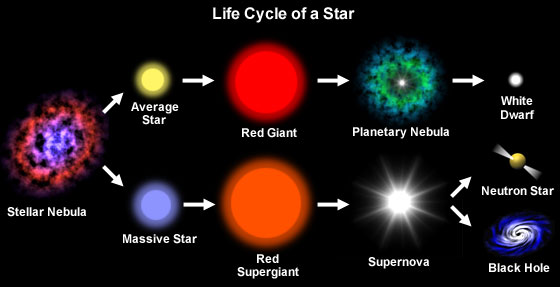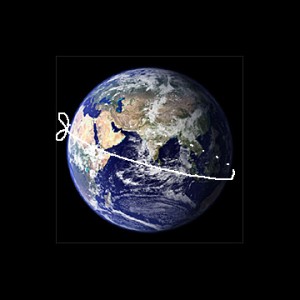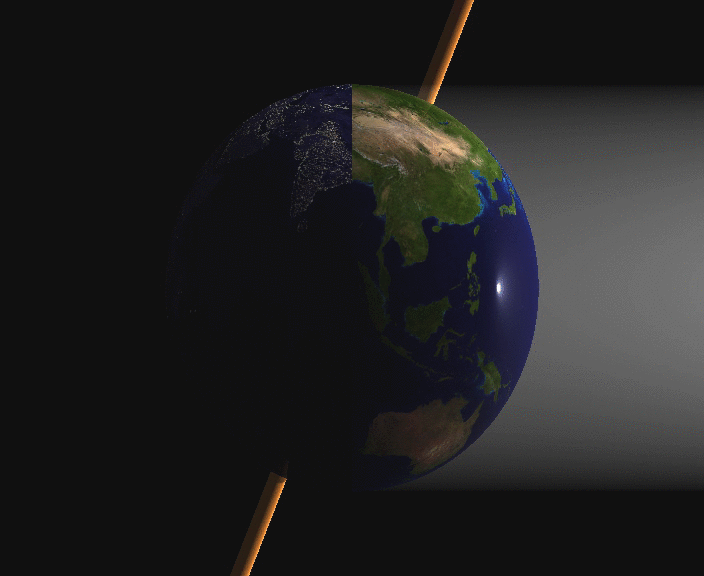IHSL Shuhrat Aripov
Friday, May 11, 2012
Thursday, April 5, 2012
Rotation & Revolution
Rotation & Revolution
Rotation- Earth moving around an its axis. (Вращение земли)
Axis- Imaginary line that Earth rotates on it. (Ось Земли)
Seasons- Each of the four different seasons (Divisions) of the year. (Времена года )
Polaris- Is a star that Earth's axis pointing at it. (Полярная звезда)
Times Zones- There are 24 Time Zones in the World (Часовые пояса)
Orbit- Its a Path that object (Moon) revolves around another (Earth) object.
(Орбита Земли)
Hemisphere- Half of the planet that is above the Equator, and half of the planet that is below the Equator (Полушарие)
Equator- It's a line that divides the Earth into two parts, and they're know as Northern & Southern Hemispheres. (Экватор Земли)
Tilt- It's Earth's sloping position, and it tilted at 23.5 degrees. (Наклон Земли )
Ellipse- Is an regular oval shape of a body.
(Овал )
 |
Summary
Earth rotates on its axis in 24 hours (1day). Earths rotation cause day & night. This Rotation is counter-clockwise. The Earth complete Revolution around the Sun once 365 days.
Earth has Time Zone's and there divided by Longitude. Earth's axis always pointed at star called Polaris, and it's titled an about 23.5 degrees.
Earth has elliptical orbit that earth revolves on it. The revolution around the cause the season, and moving of the stars.
Critical Thinking Question
How is earth affected by movement?
The revolution around the Sun takes 365 days (1year). The Earth's axis and the Earth's orbit around the Sun causes the seasons which means: Winter, Summer, Fall, and Spring. During summer Earth receives direct sunlight and gets hotter. During winter some parts of Earth receives indirect sunlight and it's really cold.
Likewise the revolution causes the Lunar Revolution which leads to changing of the Tides.
I really enjoyed to gain knowledge, learn about space like : Earth, Sun, and Moon. Also i have enjoyed is by discovering new things, and using my imagination.
What was most challenging for you during this project and why?
The most challenging part was an to figure out what is rotation and revolution. It was little challenging for me because i mixed them up.
What new skills did you learn from this project?
The new skills i have learned it was about seasons. Now I know that when is in Northern Hemisphere is summer because it gets direct sunlight, but Southern it would indirect sunlight so its winter. Also i learned that the Earth's axis is always tilted at star called Polaris.
Is there anything that you could have done to improve any of your skills?
Next time before we as a class will begin to study a new topic. I'll be study this new subject detailed, and carefully, so I understand it. What i mean by that is, that i had a little challenges for the first time.
Wednesday, December 14, 2011
Wednesday, November 16, 2011
THE STARS
What is the Star?
Star is a huge sphere of glowing gas and its very hot. One of those closest Stars to the Earth is called Sun.
 Stars produce their own light and energy by process called nuclear fusion. Stars classified by the color as: blue, orange, red and white. They are sorted by sizes as: small, medium, giant and super giant. The luminosity is how bright Star is, also sorted by the numbers from 0.0001 to 1,000,000. And temperature of the Stars from 2,000 to 50,000 (T,K). Stars also has different ages like young, middle age and old stars. Scientists use "Spectral Class" to sort and show the difference of size, luminosity, and color of the Star.
Stars produce their own light and energy by process called nuclear fusion. Stars classified by the color as: blue, orange, red and white. They are sorted by sizes as: small, medium, giant and super giant. The luminosity is how bright Star is, also sorted by the numbers from 0.0001 to 1,000,000. And temperature of the Stars from 2,000 to 50,000 (T,K). Stars also has different ages like young, middle age and old stars. Scientists use "Spectral Class" to sort and show the difference of size, luminosity, and color of the Star.
Star is a huge sphere of glowing gas and its very hot. One of those closest Stars to the Earth is called Sun.
 Stars produce their own light and energy by process called nuclear fusion. Stars classified by the color as: blue, orange, red and white. They are sorted by sizes as: small, medium, giant and super giant. The luminosity is how bright Star is, also sorted by the numbers from 0.0001 to 1,000,000. And temperature of the Stars from 2,000 to 50,000 (T,K). Stars also has different ages like young, middle age and old stars. Scientists use "Spectral Class" to sort and show the difference of size, luminosity, and color of the Star.
Stars produce their own light and energy by process called nuclear fusion. Stars classified by the color as: blue, orange, red and white. They are sorted by sizes as: small, medium, giant and super giant. The luminosity is how bright Star is, also sorted by the numbers from 0.0001 to 1,000,000. And temperature of the Stars from 2,000 to 50,000 (T,K). Stars also has different ages like young, middle age and old stars. Scientists use "Spectral Class" to sort and show the difference of size, luminosity, and color of the Star.Types of Stars
There many different types of Stars as: White Dwarf, Main Sequence, Giants, and Super Giants. White Dwarfs Stars are very small, hot, dim, and they are old Stars.
 Main Sequence Stars. They are different colors, different temperature, different sizes, and with different luminosity such as: Bright and Dim Stars. Giant Stars. They are huge, bright with lowest temperature, and they also have different colors. Super Giant Stars are really huge with lowest temperature, and highest luminosity.
Main Sequence Stars. They are different colors, different temperature, different sizes, and with different luminosity such as: Bright and Dim Stars. Giant Stars. They are huge, bright with lowest temperature, and they also have different colors. Super Giant Stars are really huge with lowest temperature, and highest luminosity.

H-R Diagram
The Hertzsprung-Russell Diagram is used by scientists to measure how far or close objects are to the Earth. It also helps astronomers to classify the temperature, luminosity, color, and the size of the Stars.
Nuclear Fusion
Nuclear fusion is the process by which multiple atoms having the same charge two atomic nuclei join together in order to form a heavier nucleus. Like Hydrogen atoms fused together to form a Helium atom. The Formula of Nuclear Fusion is
2H→He+ Energy
The Life Cycle of a Star
 Every single Star have age like humans, they all born and they all dies. Stars begin to form from clouds of gas and dust, and this process called Stellar Nebular
Every single Star have age like humans, they all born and they all dies. Stars begin to form from clouds of gas and dust, and this process called Stellar Nebular
Here is the life cycle of Sunlike Star:
Stellar Nebula - Sun Like Star - Red Giant - Planetary Nebula - White Dwarf - Black Dwarf
Here is the life cycle of Huge Star:
Stellar Nebula - Huge Star - Super Giant - Supernova - Neutron Star
This also life cycle of Giant Star:
Stellar Nebula - Giant Star - Super Red Giant - Supernova - Black Hole
There many different types of Stars as: White Dwarf, Main Sequence, Giants, and Super Giants. White Dwarfs Stars are very small, hot, dim, and they are old Stars.
 Main Sequence Stars. They are different colors, different temperature, different sizes, and with different luminosity such as: Bright and Dim Stars. Giant Stars. They are huge, bright with lowest temperature, and they also have different colors. Super Giant Stars are really huge with lowest temperature, and highest luminosity.
Main Sequence Stars. They are different colors, different temperature, different sizes, and with different luminosity such as: Bright and Dim Stars. Giant Stars. They are huge, bright with lowest temperature, and they also have different colors. Super Giant Stars are really huge with lowest temperature, and highest luminosity. 
H-R Diagram
The Hertzsprung-Russell Diagram is used by scientists to measure how far or close objects are to the Earth. It also helps astronomers to classify the temperature, luminosity, color, and the size of the Stars.
Nuclear Fusion
Nuclear fusion is the process by which multiple atoms having the same charge two atomic nuclei join together in order to form a heavier nucleus. Like Hydrogen atoms fused together to form a Helium atom. The Formula of Nuclear Fusion is
2H→He+ Energy
The Life Cycle of a Star
 Every single Star have age like humans, they all born and they all dies. Stars begin to form from clouds of gas and dust, and this process called Stellar Nebular
Every single Star have age like humans, they all born and they all dies. Stars begin to form from clouds of gas and dust, and this process called Stellar NebularHere is the life cycle of Sunlike Star:
Stellar Nebula - Sun Like Star - Red Giant - Planetary Nebula - White Dwarf - Black Dwarf
Here is the life cycle of Huge Star:
Stellar Nebula - Huge Star - Super Giant - Supernova - Neutron Star
This also life cycle of Giant Star:
Stellar Nebula - Giant Star - Super Red Giant - Supernova - Black Hole
Subscribe to:
Comments (Atom)







